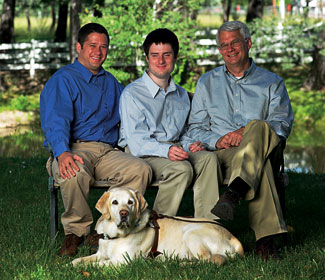Designing an Android Tablet for the Blind
The Orion 18 has many of the specs you’d expect on an Android tablet: Wi-Fi and 3G, GPS, an accelerometer, camera, 32GB of internal memory, an SD card slot, and a full-size USB port. However, in place of a traditional screen, the Orion sports a Braille display, capable of showing up to 18 characters. In July, LevelStar co-founder and chief product engineer Marc Mulcahy—who is blind—introduced the first Android tablet for the blind at the National Federation of the Blind’s annual conference.
But what does it mean to create a tablet for users who can’t see? We spoke to Mulcahy about his breakthrough device.
LAPTOP: What sparked your interested in making devices for the blind?
Mulcahy: When I was 8 or 9 years old, I put my hands on a talking computer for the first time. That was a really magical experience because it meant that I could type something into a computer and have it come out in print so my teachers could actually read it. A few years later I used my first Braille-n-Speak, which had a Braille keyboard and could talk to you. As a blind kid, you could carry this thing around and now all the magic of a computer was portable.
I always wanted to build technology that could impact blind people’s lives the way it impacted mine when I was a kid. So in 2004, my brother and my dad and I started LevelStar to try and rethink mobile devices for blind people.
Is the Orion 18’s main purpose to be an assistive device?
We’re really trying to replace a lot of simple tools for blind people. It’s not just e-mail and browsing. If you can see, you have easy access to a pencil and paper to scribble down notes or whatever. Blind people don’t do that.
Sign up to receive The Snapshot, a free special dispatch from Laptop Mag, in your inbox.
The traditional term in this market [for this kind of device] has been note takers, because that’s what they started out to be. The first product was called the Braille-n-Speak, and its primary function was taking notes with a Braille keyboard. These devices have obviously evolved over the last 20 years to include Internet, but people still call them note takers (more out of tradition than anything else). That’s one of the things that we’re trying to replace. It has to have really good input, it has to be efficient to use.
How does the Braille display work?
Each character is represented by a matrix of eight bimetallic pins that move up and down to form the various letters, numbers, and symbols. The standard Braille cell has six dots, but the cells on Braille displays traditionally have eight dots, with dots seven and eight just below dots three and six in the traditional cell.
Beyond the ability to take notes and access e-mail and web, what other features are built into the Orion 18?
We have navigation software specifically designed for the blind, supported by a built-in GPS receiver, digital compass, and accelerometer. The camera allows users to snap a picture of a printed page, and then convert the image to text, which can be read aloud or in Braille.
We also developed our own home screen to make getting around the system a little easier. We built a book reader that supports some of the specialized eBook formats and a word processor that can handle Braille documents. We also partnered with Adobe to bring DRM-protected eBooks to the device.
How good is the text-to-speech software?
We partnered with a company called Ivona. Their voices are the best in the world—the equivalent of a bright beautiful screen for our blind audience. Users can listen to the device through the built-in stereo speakers, connected headphones, or a wireless Bluetooth headset.
Did you build on Android’s existing accessibility tools when developing the Orion 18?
The built-in features definitely helped, and the existing accessibility framework is a great start, but there are a lot of things missing. For example, Android has no built-in Braille support, either for Braille input via keyboard or for output via a Braille display. We’ve added both. Also, in Gingerbread there’s no accessibility to speak of in the browser. So web content is not usable by somebody who can’t see—that’s a huge hole. That was probably the hardest problem because it’s such a big one.
What can developers do to make their apps more accessible?
There are a few simple things, like making sure that buttons have labels. You can provide a description, which will then get passed through to the accessibility tools and get spoken. That’s really the extent of it. You can also provide some descriptions or accessibility information in code, but it’s very limited.
The framework, as is, doesn’t come back and allow the accessibility tools to query an app and ask what it’s doing. Accessibility at Google is still finding its place.
When will the Orion be available and how much will it cost?
It will be released during the fourth quarter of this year and we haven’t officially announced pricing. What we’re saying at this point is that it’s going to be under $4,000. The Braille technology is expensive, and the fact that we’re making thousands of units instead of millions impacts the price.
Comparable devices in this space are $5,000. And they don’t include 3G, high-speed data, the camera, or built-in navigation software. We’re the only device in this space running Android.
K. T. Bradford writes about laptops, apps, and ebook readers for Laptop Mag. She has written reviews of some of the most iconic laptops from the last decade and more, covering models such as the Acer Aspire One, the Samsung R580, and the Lenovo IdeaPad S205. Some of her other reviews include MSI, HP, Dell, and Asus notebooks.


